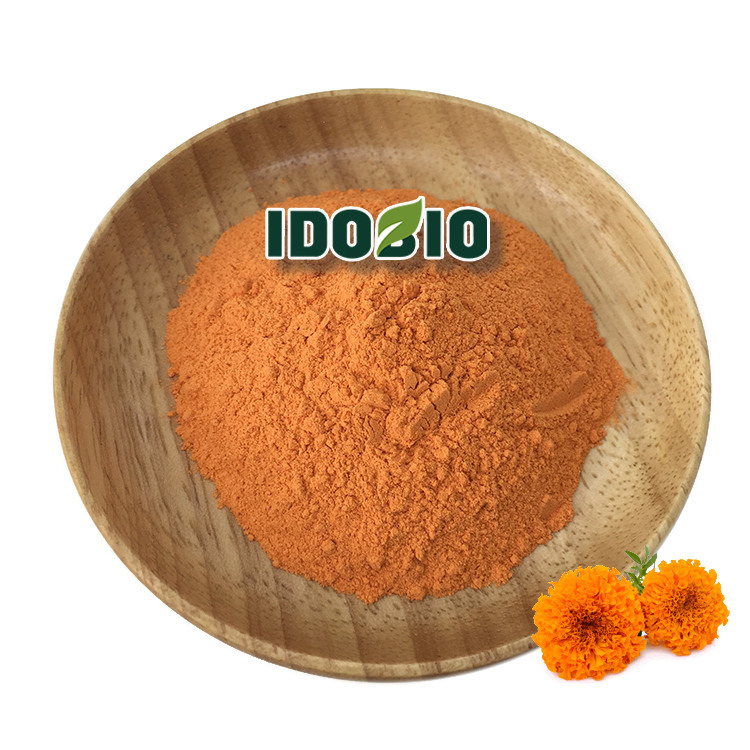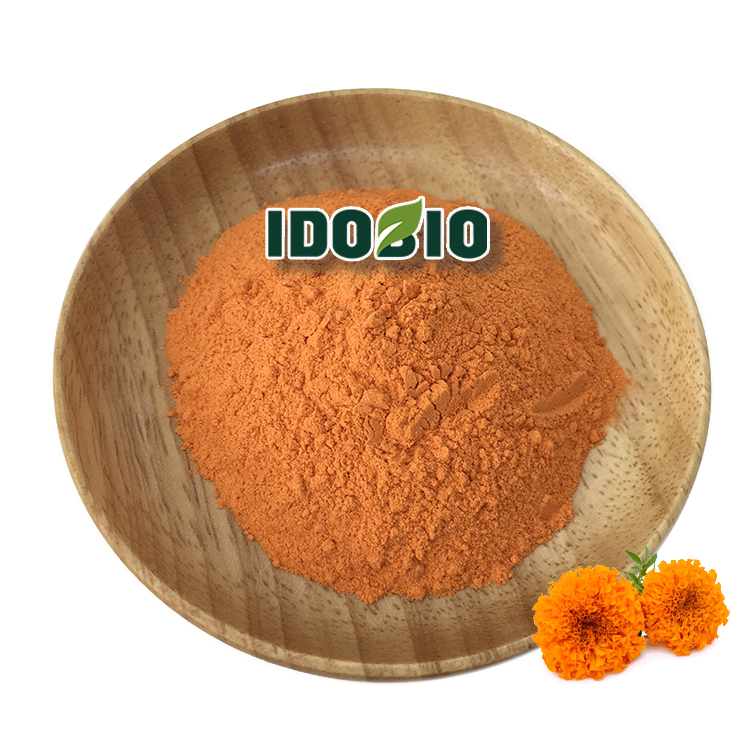Contact Us
For Product Pricing, Customization, Or Other Inquiries:
Contact Supplier
Call Us
Marigold Extract Lutein 1%-98%
English name :Lutein
CAS number 127-40-2
Molecular weight 568.871
Density 1.0±0.1 g/cm3
Boiling point 702.3±60.0 °C at 760 mmHg
Molecular formula C40H56O2
Melting point 183℃
Flash point 269.1±27.5 °C
Analysis Method: HPLC
Place of Origin:China
Packaging:1KG/Bag. 25kg/drums
The private label service:1kg/cans 500g/1kg/ Aluminum foil bag
the Capsules OEM service; 0# Capsules 500mg/pcs. 2000pcs/kg in Vacuum bag
CAS number 127-40-2
Molecular weight 568.871
Density 1.0±0.1 g/cm3
Boiling point 702.3±60.0 °C at 760 mmHg
Molecular formula C40H56O2
Melting point 183℃
Flash point 269.1±27.5 °C
Analysis Method: HPLC
Place of Origin:China
Packaging:1KG/Bag. 25kg/drums
The private label service:1kg/cans 500g/1kg/ Aluminum foil bag
the Capsules OEM service; 0# Capsules 500mg/pcs. 2000pcs/kg in Vacuum bag
Lutein, also known as carotenoid, carotenol, phytolutein, ribolutein, marigold and phytolutein, English name Lutein,
molecular formula C40H56O2, relative molecular weight is 568.85. Orange powder, slurry or liquid, insoluble in water, soluble in organic solvents such as hexane.
It can be found in leafy vegetables. Lutein itself is an antioxidant and can absorb harmful light such as blue light.
Co-existing with zeaxanthin in nature, it is the main component of plant pigments such as corn, vegetables, fruits and flowers.
It is contained in the chloroplasts of leaves, and can transfer the absorbed light energy to chlorophyll a,
which is speculated to have a protective effect on photooxidation and photodestruction.
It is also the main pigment that makes up the macular region of the retina of the human eye.
Lutein is a nutrient that can be absorbed by human daily consumption of fruits and vegetables,
but the absorption and utilization rate is generally low. If lutein is deficient, supplements can be taken.
If you have a poor digestive system in the elderly, you can use a spray under the tongue to supplement lutein.
Lutein was added as a dietary supplement as early as 1996.
In addition, excessive absorption of lutein can cause excess burden on the liver, and the recommended dosage is about 12 mg per day.

English Name :Lutein
CAS number 127-40-2
Molecular weight 568.871
Density 1.0±0.1 g/cm3
Boiling point 702.3±60.0 °C at 760 mmHg
Molecular formula C40H56O2
Melting point 183℃
Flash point 269.1±27.5 °C
Product Function
1. A major component of retinal pigment: lutein and zeaxanthin constitutes a major component of vegetables, fruits, flowers and
other plant pigments, as well as the human eye macular area main pigment. The human eye contains high levels of lutein, this
element can not be manufactured by the body and must be supplemented by the intake of lutein, if the lack of such elements, the
eyes will be blind;
2. Protect the eyes from light damage, slow aging and prevent diseases of the eye: the sun's ultraviolet radiation and blue light
entering the eye will produce a lot of free radicals, leading to cataracts, macular degeneration, and even cancer. General cornea
and lens UV filter can, but they can penetrate the eye directly to Blu-ray and macular retina, macular lutein is able to filter
out blue light, blue light to avoid damage to the eyes. Fat outer macular are particularly vulnerable to oxidative damage of
sunlight, so this area prone to degradation;
3. Antioxidant, helps prevent aging body caused by cardiovascular sclerosis, coronary heart disease and cancer.
4. Protect vision: Lutein as antioxidants and light protection, promotes retinal cells rhodopsin (Rhodopsin) re-generated, can
prevent severe myopia and retinal detachment, and can improve vision, protect eyesight. Especially for students, drivers, and
human consumption;
5. Relieve visual fatigue symptoms: (blurred vision, dry eyes, eye swelling, eye pain, photophobia, etc.
6. Raise macular pigment density, protecting the macula, macular promote development;
7. Prevent macular degeneration and retinitis pigmentosa;
8.To reduce the generation of drusen, prevent the occurrence of AMD.
Product Application
1. Lutein can lower the risk of age related vision loss, which causes gradual loss of central vision. Age related vision loss or age related macular degeneration (AMD) is caused by steady damage of the retina.
2. Lutein probably acts by preventing oxidative damage of the retina cells.
3. Lutein is concentrated in the central part of the retina, called the macula. In the macula are yellow pigments (macular pigments composed of zeaxanthin and lutein) which protect the retina from damage of the photo-oxidative affect of blue light.
4. Lutein can also reduce the risk for artery diseases. Studies have shown that persons with the highest lutein intake showed the lowest artery wall thickening.
5. Lutein also reduces the oxidation of LDL cholesterol thereby reducing the risk of artery clogging.
6. Lutein can also reduce the risk of skin cancer and sunburn. Under influence of sunlight, free radicals are formed inside the skin.
molecular formula C40H56O2, relative molecular weight is 568.85. Orange powder, slurry or liquid, insoluble in water, soluble in organic solvents such as hexane.
It can be found in leafy vegetables. Lutein itself is an antioxidant and can absorb harmful light such as blue light.
Co-existing with zeaxanthin in nature, it is the main component of plant pigments such as corn, vegetables, fruits and flowers.
It is contained in the chloroplasts of leaves, and can transfer the absorbed light energy to chlorophyll a,
which is speculated to have a protective effect on photooxidation and photodestruction.
It is also the main pigment that makes up the macular region of the retina of the human eye.
Lutein is a nutrient that can be absorbed by human daily consumption of fruits and vegetables,
but the absorption and utilization rate is generally low. If lutein is deficient, supplements can be taken.
If you have a poor digestive system in the elderly, you can use a spray under the tongue to supplement lutein.
Lutein was added as a dietary supplement as early as 1996.
In addition, excessive absorption of lutein can cause excess burden on the liver, and the recommended dosage is about 12 mg per day.

English Name :Lutein
CAS number 127-40-2
Molecular weight 568.871
Density 1.0±0.1 g/cm3
Boiling point 702.3±60.0 °C at 760 mmHg
Molecular formula C40H56O2
Melting point 183℃
Flash point 269.1±27.5 °C
Product Function
1. A major component of retinal pigment: lutein and zeaxanthin constitutes a major component of vegetables, fruits, flowers and
other plant pigments, as well as the human eye macular area main pigment. The human eye contains high levels of lutein, this
element can not be manufactured by the body and must be supplemented by the intake of lutein, if the lack of such elements, the
eyes will be blind;
2. Protect the eyes from light damage, slow aging and prevent diseases of the eye: the sun's ultraviolet radiation and blue light
entering the eye will produce a lot of free radicals, leading to cataracts, macular degeneration, and even cancer. General cornea
and lens UV filter can, but they can penetrate the eye directly to Blu-ray and macular retina, macular lutein is able to filter
out blue light, blue light to avoid damage to the eyes. Fat outer macular are particularly vulnerable to oxidative damage of
sunlight, so this area prone to degradation;
3. Antioxidant, helps prevent aging body caused by cardiovascular sclerosis, coronary heart disease and cancer.
4. Protect vision: Lutein as antioxidants and light protection, promotes retinal cells rhodopsin (Rhodopsin) re-generated, can
prevent severe myopia and retinal detachment, and can improve vision, protect eyesight. Especially for students, drivers, and
human consumption;
5. Relieve visual fatigue symptoms: (blurred vision, dry eyes, eye swelling, eye pain, photophobia, etc.
6. Raise macular pigment density, protecting the macula, macular promote development;
7. Prevent macular degeneration and retinitis pigmentosa;
8.To reduce the generation of drusen, prevent the occurrence of AMD.
Product Application
1. Lutein can lower the risk of age related vision loss, which causes gradual loss of central vision. Age related vision loss or age related macular degeneration (AMD) is caused by steady damage of the retina.
2. Lutein probably acts by preventing oxidative damage of the retina cells.
3. Lutein is concentrated in the central part of the retina, called the macula. In the macula are yellow pigments (macular pigments composed of zeaxanthin and lutein) which protect the retina from damage of the photo-oxidative affect of blue light.
4. Lutein can also reduce the risk for artery diseases. Studies have shown that persons with the highest lutein intake showed the lowest artery wall thickening.
5. Lutein also reduces the oxidation of LDL cholesterol thereby reducing the risk of artery clogging.
6. Lutein can also reduce the risk of skin cancer and sunburn. Under influence of sunlight, free radicals are formed inside the skin.







